1410, PARKSON, 44-60 ZHONGSHAN ROAD, QINGDAO, CHINA
What is hook?
A hook is a tool used to hang goods or equipment and is made of steel. The hook is divided into three parts: the hook handle, the hook back and the hook tip.
According to the direction of the upper eye loop of the hook, it is divided into front hook and side hook. The hook tip of the front hook is perpendicular to the plane of the upper eye loop of the hook, and the hook tip of the side hook is on the same plane as the upper eye loop of the hook. . Ordinary cargo hooks mostly use side hooks that have turned bad.

Precautions for the use of the hook: When using the hook, keep the force on the central part of the back of the hook to avoid breaking the hook; the strength of the hook is less than that of the shackle of the same diameter. When hanging heavy objects with heavier weight, use it instead. Shackle to avoid straightening and breaking the hook. The customized version of the chain hook needs to be manufactured by an experienced cnc operator.
Eye Hooks vs. Clevis Hooks vs. Swivel Hooks

There are two main ways a lifting hook or sling hook can be attached to the sling—you can either use a hook with an eye at the top, or with a clevis at the top to make your connection to the sling. There are also hooks that have a bearing or bushing at the top that swivels. We’ll dive a little deeper into all three of these styles below:
---Eye Hooks
On an eye hook, a chain or fittings are welded for a permanent connection to the sling. With an eye hook, you get far more flexibility in terms of movement and ergonomics to position the hook and attach it to the load. However, an eye hook is a permanent solution—if the throat of the hook becomes stretched, cracked, or bent during use, the whole sling would have to be failed out upon inspection and removed from service.
---Clevis Hooks
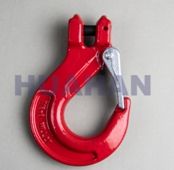 A clevis fastener is a fastener system consisting of a clevis and clevis pin. The clevis is a U-shaped piece that has holes at the end of prongs to accept the clevis pin. The clevis pin is similar to a bolt, but is only partially threaded or unthreaded with a cross-hole for a split pin. A clevis hook is a hook, with or without a snap lock, with a clevis and bolt or pin at the base. The clevis is used to fasten the hook to a bracket or chain.
A clevis fastener is a fastener system consisting of a clevis and clevis pin. The clevis is a U-shaped piece that has holes at the end of prongs to accept the clevis pin. The clevis pin is similar to a bolt, but is only partially threaded or unthreaded with a cross-hole for a split pin. A clevis hook is a hook, with or without a snap lock, with a clevis and bolt or pin at the base. The clevis is used to fasten the hook to a bracket or chain.
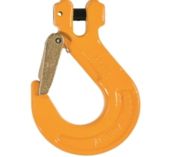 Some rigging shops and end users who are not certified to weld alloy chain slings, utilize clevis hooks to make a mechanical connection to a chain sling. The advantage of a mechanical connection is that if a clevis hook becomes damaged due to stretch, bending, or cracking, it can easily be removed and replaced without scrapping the entire chain sling. If this occurs on a chain sling, this is considered a repair to the sling and must be proof-tested prior to the sling being put back into service.
Some rigging shops and end users who are not certified to weld alloy chain slings, utilize clevis hooks to make a mechanical connection to a chain sling. The advantage of a mechanical connection is that if a clevis hook becomes damaged due to stretch, bending, or cracking, it can easily be removed and replaced without scrapping the entire chain sling. If this occurs on a chain sling, this is considered a repair to the sling and must be proof-tested prior to the sling being put back into service.
Also, a clevis hook can pivot side to side for positioning when connecting to a load, but doesn’t have the same flexibility or freedom of movement that an eye hook does.
---Swivel Hooks
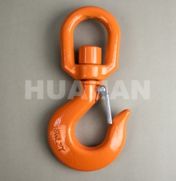 There are two types of swivel hooks and the user should be aware of the type of swivel hook that they’re using prior to lifting a load into the air:
There are two types of swivel hooks and the user should be aware of the type of swivel hook that they’re using prior to lifting a load into the air:
Positioning Swivel Hook – This type of hook swivels to allow the rigger to properly align the hook during connection to the load. This type of hook is NOT designed to rotate while under load and is only to be used when you need to position the hook onto the pick point.
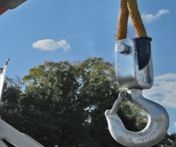 True Swivel Hook with Bearing – This type of swivel hook has a bearing inside that allows the hook to rotate freely under load. The top fitting swivels and pivots to allow the load to rotate to prevent twisting of the rigging.
True Swivel Hook with Bearing – This type of swivel hook has a bearing inside that allows the hook to rotate freely under load. The top fitting swivels and pivots to allow the load to rotate to prevent twisting of the rigging.
---Grab Hooks
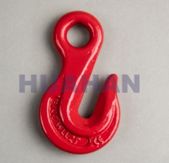 Grab Hooks are designed with a special narrow throat used to “grab” and shorten or hold a length of chain used in overhead lifting applications. The throat engages the chain between the links for quick non-slip handling. There are two types of grab hooks, so the end-user should understand what type of grab hook they’re using prior to lifting a load into the air:
Grab Hooks are designed with a special narrow throat used to “grab” and shorten or hold a length of chain used in overhead lifting applications. The throat engages the chain between the links for quick non-slip handling. There are two types of grab hooks, so the end-user should understand what type of grab hook they’re using prior to lifting a load into the air:
Standard grab hook – When shortening a sling leg using a standard grab hook, you need to reduce the Working Load Limit by 20%. These standard grab hooks are popular because they’re less expensive than a cradle grab hook.
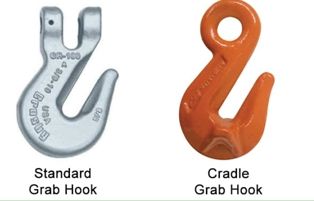
Cradle grab hook – The belly of a cradle grab hook is casted like a hammock for a piece of chain to lay in. Generally speaking, if you shorten a length of chain using a cradle grab hook, you have 100% of the Working Load Limit.
---FORGED OR CAST?
Casting is a method that shapes molten metal by pouring the liquefied metal into a mold. The mold creates a desired shape and is comparable to pouring water into an ice try and letting it freeze to form a frozen square.
Forging also uses heated metal, but keeps the metal in a solid, yet malleable state. Forging dates back to the times of blacksmithing and is considered to be one of the oldest methods of metalworking.
Casting is best for pieces that are intricate, or have a design that requires cavities and can be used with a wide spectrum of alloy choices. Forging is best for operations that require exceptional strength and uniform design. This type of rigging hardware is excellent at handling impacts.
Find more information about hook, click: